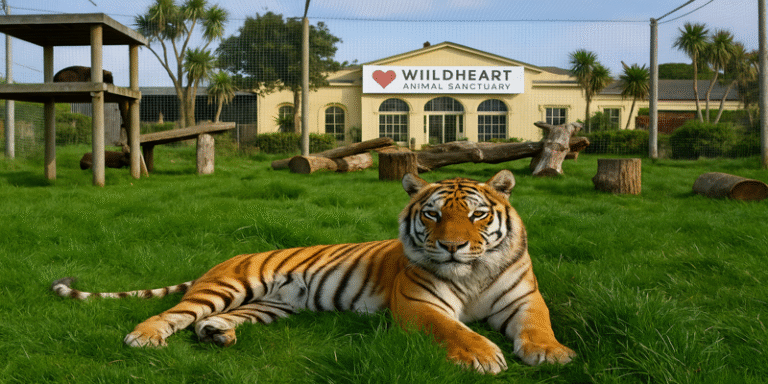Tucked away in the coastal town of Sandown, on the sun-drenched eastern shore of the Isle of Wight, lies one of the island’s most inspiring and educational tourist attractions: the Wildheart Animal Sanctuary. Formerly known as the Isle of Wight Zoo, this cherished site has transformed into a symbol of ethical wildlife conservation and a holiday highlight for animal lovers, families, and eco-conscious travellers alike.
A Legacy of Compassion
The Wildheart Animal Sanctuary has a long-standing history, dating back to the 1950s, but it gained momentum in the 1970s when it became home to a growing collection of big cats, most of them rescued from travelling circuses or unsuitable private ownership (Wildheart Trust, 2024). Over time, the zoo evolved into a conservation-driven sanctuary, aiming to create a better future for animals in need, particularly those endangered or mistreated in captivity.
Since its rebranding in 2021, the sanctuary has positioned itself as a non-profit charitable trust, focused not only on rescue and rehabilitation but also on raising public awareness about animal welfare, biodiversity, and the importance of ethical wildlife tourism (Wildheart Animal Sanctuary, 2024).
Ethical Tourism and Wildlife Conservation
One of the key reasons why the Wildheart Animal Sanctuary is celebrated is its alignment with the principles of sustainable tourism. According to Honey (2008), responsible tourism involves “travel that minimises negative environmental, social and cultural impacts” while enhancing the well-being of host communities and promoting conservation awareness.
The sanctuary does exactly that. By rescuing exotic animals—primarily tigers, lions, and lynx—from unethical or dangerous environments, it allows these creatures to live in habitats that closely mimic their natural environments, under expert veterinary care. Guests can observe the animals from a safe distance, contributing directly to their care with every ticket purchased (Balmford et al., 2009).
This approach offers a sharp contrast to more exploitative attractions that allow animal interaction or performances. As Rees (2024) argues, zoos and sanctuaries must shift away from entertainment models and toward welfare and conservation-led missions—a philosophy that Wildheart embodies wholeheartedly.
Education as a Central Mission
The Wildheart Sanctuary is more than just a place to observe majestic animals—it’s an immersive educational experience. Children and adults alike leave with a deeper understanding of animal welfare challenges, the illegal wildlife trade, and the urgency of conservation. The sanctuary runs school programmes, guided tours, and interactive displays that explain the plight of captive wildlife and what individuals can do to help.
Educational tourism has been found to significantly influence conservation behaviour (Orams, 1997). Through compelling storytelling and transparent care routines, the sanctuary demonstrates the impact humans can have—both positive and negative—on wild species. As one visitor remarked, “I came for the tigers, but left with a completely new respect for the people who care for them” (Tripadvisor, 2024).
A Family-Friendly Experience
From a tourism perspective, the Wildheart Animal Sanctuary offers a perfect day out for families. With facilities such as an eco-conscious café, gift shop, accessible paths, and even a nature-themed playground, it caters to visitors of all ages and abilities. What makes the experience truly unique is the chance to get up close—yet responsibly distant—from apex predators, like their rescued white lions, without compromising the animals’ dignity or freedom.
Children are especially engaged by the storytelling sessions and the sanctuary’s famous “Meet the Keeper” talks. These interactions allow young minds to ask questions and learn directly from wildlife professionals—encouraging curiosity and empathy from an early age (Falk et al., 2007).
Volunteering and Behind-the-Scenes Experiences
For those looking to deepen their connection to animal welfare, the sanctuary also offers volunteering opportunities and “Keeper for a Day” experiences. These programs enable participants to work alongside animal care teams, helping prepare food, maintain enclosures, and observe health checks. These are not just gimmicks but thoughtfully designed experiential learning encounters, ideal for aspiring zoologists, conservationists, or ethical tourists seeking more than just sightseeing (Ballantyne et al., 2009).
Conservation Beyond the Isle
While the sanctuary provides a safe haven for animals on the Isle of Wight, its impact extends far beyond British shores. The Wildheart Trust, which manages the sanctuary, supports international conservation projects, particularly in India and Africa, where many of their resident species originate. This includes working with on-the-ground partners to tackle poaching, habitat loss, and the illegal wildlife trade—problems that threaten biodiversity globally (IUCN, 2022).
According to Carver et al. (2010), engaging the public in the global context of conservation enhances understanding and encourages behaviour that supports planetary ecological well-being. The sanctuary’s dual role as both a local attraction and global conservation advocate makes it a beacon of ethical tourism on the island.
Wildlife, Wellness, and the Wight
Visitors often note how their time at Wildheart complements the overall peaceful vibe of the Isle of Wight. Located near the golden beaches of Sandown, visitors can easily combine a morning learning about rescued big cats with an afternoon stroll along the esplanade or a swim in the sea. The synergy between the sanctuary and the island’s natural landscape creates a holiday that rejuvenates both body and mind—slow tourism at its finest.
In an age of climate anxiety and ecological collapse, visiting places like the Wildheart Animal Sanctuary reconnects people with nature’s resilience. As Shults (2023) writes, “wildlife tourism can inspire love for species far from home—sparking the kind of emotional commitment that leads to conservation change.”
Planning Your Visit
- Location: Yaverland Road, Sandown, Isle of Wight PO36 8QB
- Opening Hours: 10:00 am to 4:30 pm daily (seasonal changes may apply)
- Accessibility: Wheelchair friendly, with on-site disabled parking and assistance available
- Website: https://wildheartanimalsanctuary.org
- Public Transport: Easily accessible via Southern Vectis buses and Island Line Railway
Whether you’re on the Isle for a weekend or an extended holiday, the Wildheart Animal Sanctuary offers a chance to experience something both enriching and impactful. It’s not just a tourist destination; it’s a space of transformation—for animals, visitors, and the planet.
References
Ballantyne, R., Packer, J. and Falk, J.H. (2009). ‘Visitors’ learning for environmental sustainability: Testing short- and long-term impacts of wildlife tourism experiences using structural equation modelling’. Tourism Management, 30(3), pp.375–384.
Balmford, A., Beresford, J., Green, J., Naidoo, R., Walpole, M. and Manica, A. (2009). ‘A global perspective on trends in nature-based tourism’. PLOS Biology, 7(6), pp.1–6.
Carver, S., Fisher, M. and Kun, Z. (2010). Review of Status and Conservation of Wild Land in Europe. [online] Available at: https://www.self-willed-land.org.uk.
Falk, J.H., Heimlich, J.E. and Bronnenkant, K. (2007). ‘Using Identity-Related Visit Motivations as a Tool for Understanding Adult Zoo and Aquarium Visitors’ Meaning-Making’. Curator: The Museum Journal, 51(1), pp.55–79.
Honey, M. (2008). Ecotourism and Sustainable Development: Who Owns Paradise? Washington, DC: Island Press.
IUCN (2022). Conservation for Species Survival. [online] Available at: https://www.iucn.org.
Rees, P. (2024). ‘Key Questions in Wildlife & Nature Conservation Law’. CABI Publishing.
Shults, S. (2023). Gone on Vacation. [Google Books] Available at: https://books.google.com.
Tripadvisor (2024). Wildheart Animal Sanctuary – Visitor Reviews. [online] Available at: https://www.tripadvisor.co.uk.
Wildheart Animal Sanctuary (2024). Our Mission. [online] Available at: https://wildheartanimalsanctuary.org.









